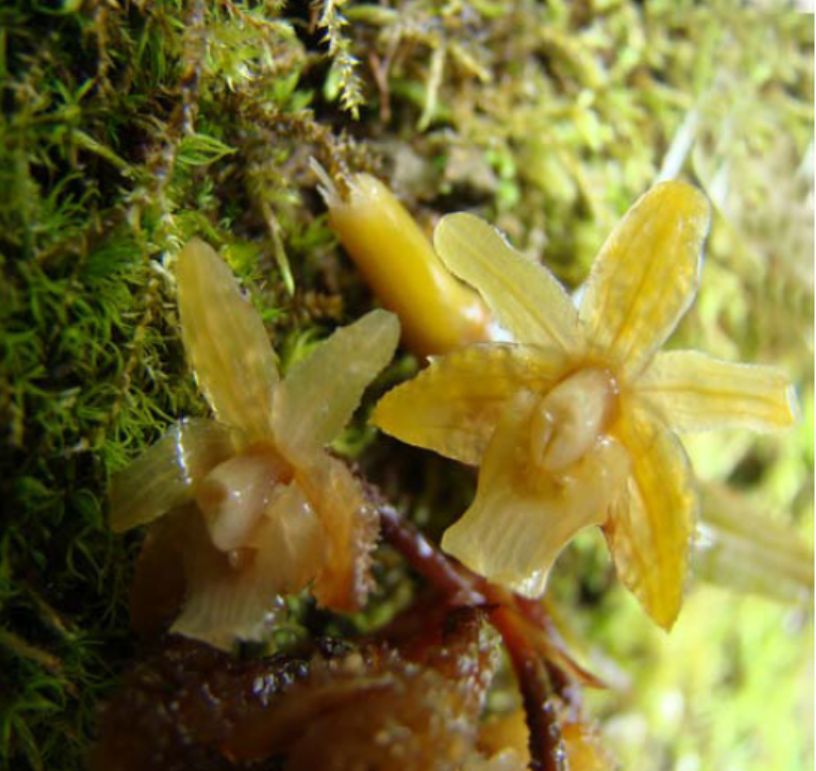

Epidendrum astetei Hágsater, Collantes & Mormontoy 2013 GROUP Diothonea SUBGROUP Diothonea
Photo by Hagsater/TYPE Drawing by © Jimenez, Hágsater & E.Santiago and The AMO Herbario Website



Common Name Astete's Epidendrum [Peruvian Anthropologist and Archeologist and director of the Macchu Picchu Park current]
Flower Size .64" [1.6 cm]
Found in southern Peru at Macchu Picchu at elevations around 3000 to 3780 meters as a medium sized, cold growing lithophyte with branching, the new stem produced from an apical internode of the previous stem, cane-like, terete, thin, erect stems carrying about 5, all along the apical half of the stem, distichous, articulate, subcoriaceous, coriaceous, linear-lanceolate to lanceolate-oblong, subacute to subobtuse, minutely apiculate to ancistrous, basally clasping leaves that blooms in the summer on a terminal, racemose, arching-nutant, short, pustulate, to sub-aculeate papillae, densely, successively 2 to 3, to 11 flowered inflorescence with half as long as the ovary, prominent, narrowly triangular, amplexicaul floral bracts.
" Epidendrum astetei belongs to the GROUP Diothonea SUBGROUP Diothonea which is characterized by the branching plants, linear lanceolate to oblong, bilobed leaves, racemose, arching-nutant inflorescence, membranaceous flowers (rarely fleshy), the entire to 3-lobed, ecallose lip with the margin erose without or with 1 to 10 thin, smooth to erose ribs, the column completely to obliquely united to the lip, the anther reniform. The species is recognized by the sac-like, hemi-spherical base of the lip, the disc with two pairs of blade-like ribs, the anterior pair well developed, sigmoid-folded, with the inner (knees) edges intrusive in the stigmatic cavity, and the continuation bent at approximately 80°, becoming adnate laterally outwards; the anterior edges are visible from outside the flower as two contiguous calli bellow the apex of the column; in between, hidden, like a central brick is another hemi-cordate rib. Epidendrum trachypentatropis Hágsater & E.Santiago has small reddish flowers, dorsally muricate sepals .22 to .248" [5.5 to 5.7 mm] long, and the sack-like lip nearly totally united to the column, with 5 prominent, unequal, flat, laminar keels hidden below the column. Epidendrum trachysepalum Hágsater has up to 9 to 11, pale pink to yellowish brown flowers with wine-red veins, the sepals are strongly muricate, the lip totally free from the column and is adorned with 3 thin, ribs at the base of the lip, the lateral pair is “U” shaped, and the mid-rib only appears on the disc, so on the disc it appears to be 5-ribbed. Epidendrum cryptotropis Hágsater, Collantes & E.Santiago has yellowish green flowers with the edges of sepals and petals and the veins marked with purple, sepals .4 to .48" [10 to 12 mm] long, dorsally smooth, the lip entire, sub-pandurate. Epidendrum trachydipterum Hágsater, W.Nauray & E.Santiago has linear-lanceolate leaves 2.2 to 2.92" x .14 to .2" [5.5 to 7.3 x 0.35 to 0.5 cm], the inflorescence is lax and few flowered, petals linear and the lip has 5 laminar ribs." Hagsaer etal 2013
Synonyms
References W3 Tropicos, Kew Monocot list , IPNI ; *Icones Orchidacearum 14 Plate 1409 Hagsater & Sanchez 2013 drawing/photo fide; Icones Orchidacearum 14 Plate 1419 Hagsater & Santiago 2013 See recognition section; Icones Orchidacearum 14 Plate 1490 Hagsater & Santiago 2013 See recognition section; Icones Orchidacearum 17(1) Plate 1709 Hagsater & Jimenez 2019 see recognition section
--------------------------------------------------------------------------------------------------------------------------
----------------------------------------------------------------------------------------------------------------------------